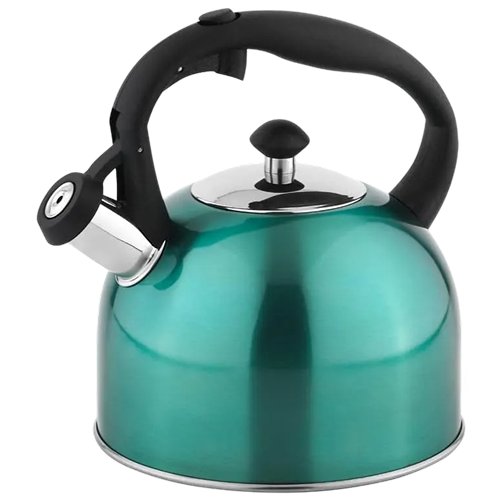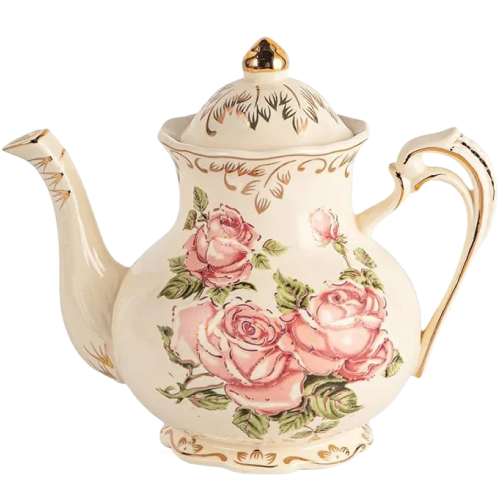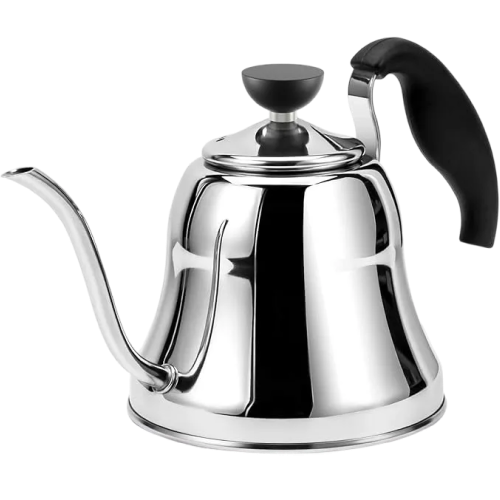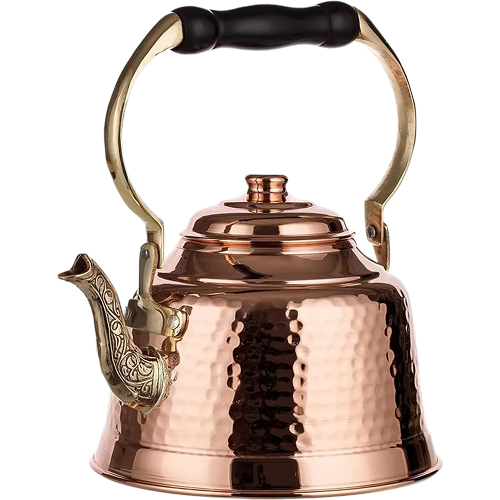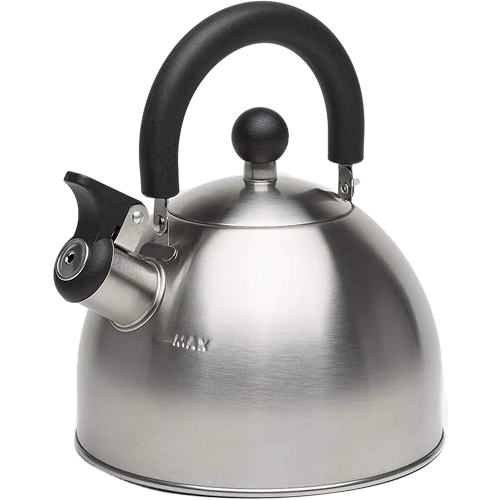After owning five different kettles over fifteen years, I can tell you that the whistle does far more than make noise. That sound has saved me from burning through several kettle bottoms when I got distracted. Water boiling dry on a stove creates a real fire hazard.
This guide explains how to recognize the key design and construction features that separate durable whistling kettles from those that fail within a couple of years.
The Whistle: Your Most Important Safety Feature
The whistle mechanism defines this category, so let’s start there.
Whistle Mechanism Types
Whistles vary by design, and that difference affects both usability and safety.
- Two-tone whistles. A two-tone automatic whistle has dual chambers that create a loud, distinctive sound audible throughout your house. Steam pressure triggers the whistle automatically without any manual intervention.
- Single-tone whistles. These versions are simpler and produce one clear note. They are adequate for smaller spaces, but easier to miss with background noise.
- Manual flip whistles. A model with a manual flip whistle requires you to open a spout cap before pouring. They’re fine for general use, but you’re adding an extra step when handling a kettle full of boiling water.
- Basic fixed whistles. These are the cheapest models, often with a simple hole-and-cap design. Quietest option and least durable over time.
What actually matters when you’re using the kettle daily:
- Two-tone design for maximum audibility
- Automatic activation to keep hands away from the steam
- Stainless steel construction for longevity and heat resistance
Whistle Volume Levels
Whistle volume is measured in decibels (dB) and it matters more than you’d think. The louder the sound, the more effective it is as a safety alert. A whistle rated at 75+ dB will alert you from anywhere in a typical home. Mine competes with the HVAC system, the dishwasher running, and people talking in the other room. The 65-74 dB range handles apartments or smaller houses, but open floor plans with high ceilings drown them out.
Any whistle volume below 65 dB is too quiet to be reliable. I’ve seen kettles that produce such weak sounds you won’t hear them from the next room with a TV on. Defeats the entire safety purpose of having a whistling kettle in the first place.
Material Construction: The Foundation of Performance
Quality starts with what your kettle is made from.
Body Material Quality
Those stainless steel numbers actually mean something. 18/10 grade contains 18% chromium and 10% nickel. That combination resists corrosion better than the alternatives. Mine gets used four times daily and, after twelve years, it shows zero rust or pitting.
Avoid 18/0 stainless steel entirely – the lack of nickel content means faster rust and shorter life. Aluminum is cheaper but leaches into water and dents easily. Enamel-coated steel looks good until chips expose bare metal underneath.
Interior Surface Quality
A full stainless steel interior is a non-negotiable for me; it prevents flavor transfer, is resistant to staining from minerals in hard water, and is easy to clean. Enamel interiors might look nice initially, but chip damage is inevitable.
Watch out for exposed seams on cheaper kettles. Those joints trap mineral deposits that are nearly impossible to clean out completely. After a few months, you’ll see white buildup that affects the water taste. Quality kettles use seamless construction or fully welded interiors.
Heat Performance and Stovetop Compatibility
Boil time depends entirely on base construction. Most people obsess over capacity or appearance when the base is what actually determines performance.
Bottom Construction
- Tri-ply encapsulated base – Stainless steel layers sandwich an aluminum or copper core. The aluminum core conducts heat faster than stainless alone, cutting boil times by 30-40% compared to single-layer bases. I’ve measured this myself with a timer over three months of daily use. Copper cores heat up even faster, but they cost more.
- Disc base – Layered construction only at the bottom, offers a middle ground between single-layer and full tri-ply construction.
- Single-layer base – Single-layer stainless bottoms are what you get on budget kettles. Heat transfer is slow and uneven. Hot spots can warp the base over time, especially on high heat.
Here’s why the encapsulated design makes sense: you get the strength and non-reactivity of stainless steel with the thermal conductivity of aluminum or copper where you need it most. It’s simple physics. That’s why I paid extra for tri-ply on my own kettle.
Stovetop Compatibility
Induction cooktops require magnetic bases, which means the kettle needs a steel layer on the bottom. Gas, electric coil, and ceramic stovetops work with any base material.
Even if you have a gas stove now, buy an induction-compatible one. You never know what your next home will have. Three moves in ten years taught me this lesson. Gas stove in the first place, electric in the second, induction in the third. The same kettle worked on all of them. The extra $10-$15 for compatibility beats buying a new kettle when you move.
Safety Features Beyond the Whistle
Burns from hot handles and steam exposure send more people to the ER than you’d guess. Most folks don’t think about this until after their first injury.
Handle Heat Resistance
Silicone-coated handles remain cool at full boil. I grab mine barehanded after ten minutes on high heat. Phenolic resin handles resist heat but warm up enough that you’ll want a towel for safety. Bakelite handles fall somewhere in between.
Bare metal handles are dangerous. Period. They’re hot enough to cause second-degree burns within minutes of heating. I won’t recommend any kettle that uses exposed metal handles.
Check how the handle attaches. Welded handles are the most durable and won’t come loose over time. Riveted construction is acceptable, but it can develop play after years of use. Bolted handles are the weakest connection, and I’ve seen them fail catastrophically when the kettle is full.
Lid Opening Mechanisms
Push-button trigger releases are the safest design. A button on the handle flips the lid up while keeping your fingers away from the steam blast. Single-hand pouring leaves your other hand free to hold your cup or steady the kettle base.
Lever flip-up lids work, but place your hand right in the steam path when you open them. Manual lift-off lids with stay-cool knobs require two hands and careful coordination. Metal knobs on lift-off lids are a burn hazard. I’ve seen people drop these lids into sinks when the knob gets too hot to hold.
Spout Design
Anti-drip spouts channel water cleanly without dribbling down the kettle’s exterior. This isn’t just about mess. Boiling water running down the outside burns hands or damages countertops. Precision pour spouts give you the control needed for French press or pour-over coffee preparation.
Standard pour spouts handle everyday tea making without issues. Wide-mouth spouts splash excessively and spill when pouring into narrow openings. The spout design makes a bigger difference than most buyers expect.
Capacity and Practical Considerations
Size and stability affect daily usability more than most buyers realize.
Choosing the Right Size
The 2.5 to 3-quart range (2.4–2.8 liters) handles most household needs. That capacity serves multiple cups without taking forever to boil. My 2.8-quart kettle serves four large mugs with room left over. Smaller kettles (1.5–2 quarts) work for individuals but require constant refilling when guests visit.
Capacity affects weight when full. Three quarts of water weigh over 6 pounds. Add the kettle itself, and you’re lifting 7-8 pounds. If that feels too heavy, step down to a smaller size, like 2 quarts (but expect more frequent refills).
Base Diameter and Stability
Wider bases (7 inches or more) provide better stability and faster heating. A flat, stable platform maximizes contact with your burner or cooktop surface, meaning water boils quicker and the kettle uses less energy. Narrow bases (under 6 inches) create a top-heavy kettle when full and are more prone to tipping. I’ve almost knocked one over while reaching across the stove – I won’t repeat that mistake.
Warranty and Long-Term Value
Look at the warranty first. Lifetime coverage shows the manufacturer believes in their materials and construction. They’re willing to back the product forever because failures are rare. Mine has twelve years of daily use without problems.
Five-year warranties work for most mid-range kettles. Anything shorter suggests expected failures within that timeframe. Anything limited to one year or less usually means the manufacturer knows they cut corners and won’t stand behind long-term performance.
When comparing prices, think of the cost per year. Spending $120 on a kettle that lasts twenty years is cheaper in the long term than replacing a $60 one every three years.
Common Mistakes When Buying Whistling Kettles
Most buyers make the same avoidable mistakes when choosing a whistling kettle. Here’s what I see most often:
- Prioritizing looks over engineering. Buyers pick based on looks first. Colored enamel finishes attract attention but mean nothing if the whistle can’t be heard or the handle causes burns. I bought a gorgeous copper-finish kettle once. The terrible single-layer base, heated unevenly, lasted eighteen months before warping.
- Ignoring base construction. Single-layer bottoms cost less upfront but waste energy and time every single day. Over a kettle’s lifespan, the extra minutes and electricity add up. Skipping induction compatibility saves maybe $10–$15, but limits your options if you move or upgrade your kitchen.
- Overlooking whistle performance. The biggest mistake, in my opinion, is assuming that all whistles work equally well. Volume and mechanism quality vary wildly between models. Find reviews that discuss actual loudness levels instead of just appearance.
- Assuming price equals whistle quality. I’ve tested $150 kettles with weak, barely audible whistles and $70 models with loud two-tone mechanisms. Material quality and construction justify higher prices, but whistle performance varies independently of cost. Check specifications instead of trusting price tags.
Which Whistling Kettle is Right For You?
Figure out what matters most to you. Safety comes first in my opinion and should be your top priority. Automatic two-tone whistles, silicone-coated handles, and push-button lid releases should be non-negotiable. Larger homes or noisy kitchens need whistles rated at 75+ dB minimum.
Performance-focused buyers benefit most from tri-ply encapsulated bases with aluminum cores. They’ll save you time every morning and use less energy over the kettle’s life. Buy induction-compatible even if you don’t need it now. This covers future moves or kitchen remodels.
Shopping on a budget? I would still maintain essential standards: 18/8 stainless steel, automatic whistles, and stay-cool handles. Sacrifice cosmetic extras, not core safety or construction features. A mid-range kettle lasting ten years beats a cheap one failing in two.
A high-quality $80–$120 kettle with proper engineering outlasts and outperforms multiple budget models. In the long run, quality saves both time and money.


